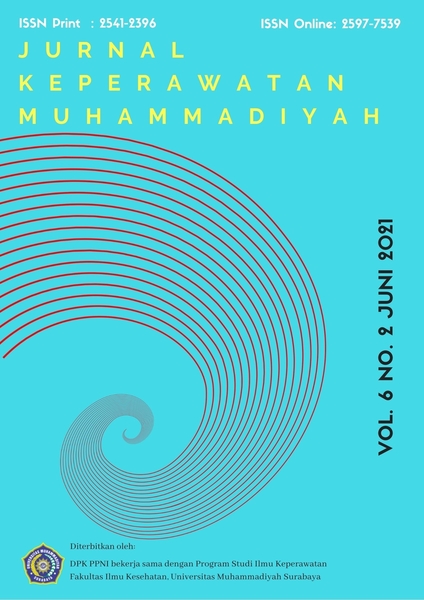Hubungan Kualitas Hidup Lansia dengan Food Intake di Panti Sosial Tresna Werdha Ina Kaka Ambon
DOI:
https://doi.org/10.30651/jkm.v6i1.7732Keywords:
Lansia, Kualitas Hidup, Food IntakeAbstract
Abstract
The decline in the functioning of the body's systems in the elderly as they get older can change certain nutritional aspects such as the sense of smell and taste, the ability to chew and swallow and the digestive function makes food uncomfortable and the elderly's appetite decreases . The decrease in food intake certainly affects the quality of life of the elderly. Food intake is one of the important factors to meet the needs of good nutritional intake. Elderly with high quality of life can cover all existing domains and also a good food intake for the changes experienced by the elderly. So that it becomes the basis of the importance of improving the quality of life and food intake of the elderly. The study was conducted to explore the relationship between quality of life and food intake at the Tresna Werdha Inakaka Social Home in Ambon. Research using quantitative methods with descriptive correlation design. The respondents involved were the elderly at the Tresna Werdha Ina Kaka Social Home, Ambon. Sampling using purposive sampling technique with respondents as many as 36 elderly. The data were processed using the excel program and then tested using the SPSS program to determine the relationship between variables. Data analysis using SPSS 20 correlation test or correlation using Pearson Product Moment with a significance level of 0.05. The results showed that there was a relationship between variables in quality of life and food intake, with a moderate degree of correlation that led to a positive direction (r = 0.502; p = 0.002; p <0.05). Based on the results of the study, it can be concluded that in the Tresna Werdha Ina Kaka Social Home, the quality of life and food intake have a moderate relationship, the higher the quality of life the better the food intake for the elderly.
Keywords: Elderly, Quality of Life, Food Intake
References
DAFTAR PUSTAKA
Adhiyani, C. (2013). Hubungan Usia dan Konsumsi Makanan Berlemak dengan Kolesterol Total Pada Lansia Kelurahan Serengan Surakarta. Jurnal Farmasi (Journal of Pharmacy), 2(1, Oktober), 12.
Amarantos, E., Martinez, A., & Dwyer, J. (2001). Nutrition and quality of life in older adults. The Journals of Gerontology series A: Biological sciences and Medical sciences, 56(suppl_2), 54-64.
Angraini, D. I., Supartinah, A., & Wachid, D. N. (2013). Status kesehatan mulut dan asupan makan sebagai faktor risiko underweight pada lansia. The Indonesian Journal of Clinical Nutrition, 9(4), 188-196.
Azizah. Lilik Ma‘rifatul. (2011). Keperawatan Lanjut Usia. Yogyakarta: Graha Ilmu.
Badan Pusat Statistik. (2018). Statistik Penduduk Lanjut Usia Tahun 2018. Jakarta : Badan Pusat Statistik.
Barasi ME. At a glance ilmu gizi. Jakarta: Penerbit Erlangga; 2009.
Cendanawangi, D. N., Tjaronosari, T., & Palupi, I. R. (2016). Ketepatan porsi berhubungan dengan asupan makan pada lanjut usia di Panti Sosial Tresna Werdha Budi Luhur, Bantul, Yogyakarta. Jurnal Gizi dan Dietetik Indonesia (Indonesian Journal of Nutrition and Dietetics), 4(1), 8-18.
Irawan, H. (2013). Gangguan depresi pada lanjut usia. Cermin Dunia Kedokteran, 40(11), 815-819
Juniarti, N. Eka, S. & Damayanti, A. (2008); Gambaran Jenis dan Tingkat Kesepian Pada Lansia di Balai Panti Sosial TresnaWredha Pakutandang Ciparay Bandung,Skripsi, Fakultas Ilmu Keperawatan Universitas Padjajaran, hal 3.
Karim, D. (2015). Hubungan dukungan sosial teman sebaya dengan kualitas hidup lansia di panti sosial tresna werdha (Doctoral dissertation, Riau University).
Komnas Lansia. (2010). Profil Penduduk Kesehatan Lanjut Usia. Jakarta: Kemenkes RI.
Maryam, S. (2008). Menengenal usia lanjut dan perawatannya. Penerbit Salemba.
Nurgoho,W. 2008. Keperawatan Gerontik dan Geriatrik, EGC, Jakarta
Nursanyoto Hertog. 2012. Nutrisi Anti Penuaan Dina. Yogyakarta. Nuha Medika Nursilmi, N., Kusharto, C. M., & Dwiriani, C. M. (2017). Hubungan Status Gizi
dan Kesehatan dengan Kualitas Hidup Lansia di Dua Lokasi Berbeda. Media Kesehatan Masyarakat Indonesia Universitas Hasanuddin, 13(4), 369-379.
Plastow, N. A., Atwal, A., & Gilhooly, M. (2015). Food activities and identity maintenance in old age: a systematic review and meta-synthesis. Aging & mental health, 19(8), 667-678.
Profil Kesehatan Kota Ambon, 2015.
Risdianto. (2009). Hubungan dukungan sosial dengan kualitas hidup lanjut usia di Desa Kembang Cepogo Boyolali. Surakarta : UMS.
Rosiana, A., & ERwanti, E. (2019). HUBUNGAN STATUS GIZI DAN AKTIVITAS FISIK DENGAN KUALITAS HIDUP LANSIA DI DESA TLOGOSARI PATI TAHUN 2017. Proceeding of The URECOL, 519-526.
Rohmah, A. I. N. Purwaningsih dan Bariyah K.(2012) Kualitas hidup lansia. Jurnal Keperawatan, ISSN 2086, 3071.
Schünemann, H. J., Sperati, F., Barba, M., Santesso, N., Melegari, C., Akl, E. A.,
& Muti, P. (2010). An instrument to assess quality of life in relation to nutrition: item Hubungan Status Gizi Dan Aktivitas Fisik Dengan Kualitas Hidup Lansia Di Desa Tlogosari Pati Tahun 2017. Proceeding Of The Urecol, 519-526.generation, item reduction and initial validation. Health and quality of life outcomes, 8(1), 26.
Supariasa, I. D. N., Bakri, B., & Fajar, I. (2001). Penilaian Status Gizi, Jakarta. Penerbit buku kedokteran EGC.
Tamba, I. B. (2013). Susunan Variasi Makanan Kaitannya Dengan Tingkat Selera Makan Lansia Di Panti Werdha Yayasan Guna Budi Bakti Medan Labuhan (Doctoral Dissertation, Unimed).
Downloads
Published
Issue
Section
License
- Penulis tetap memegang hak atas karyanya dan memberikan hak publikasi pertama kepada jurnal ini yang secara simultan karya tersebut dilisensikan di bawah:Â Creative Commons Attribution-ShareAlike 4.0 International (CC BY-SA 4.0)













